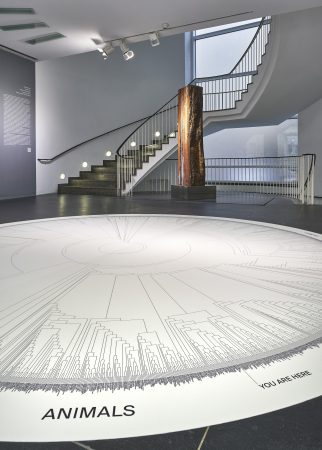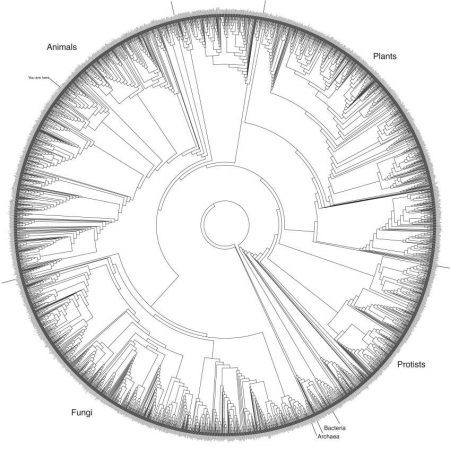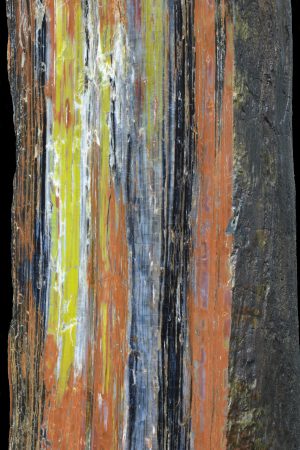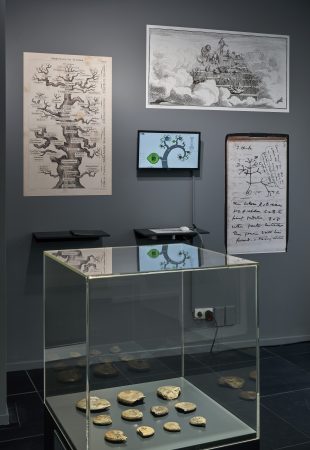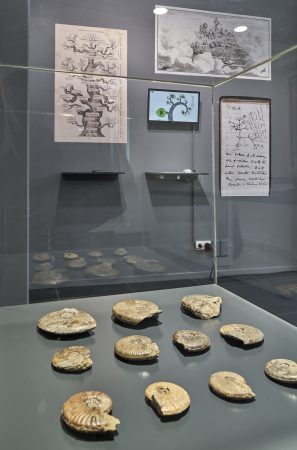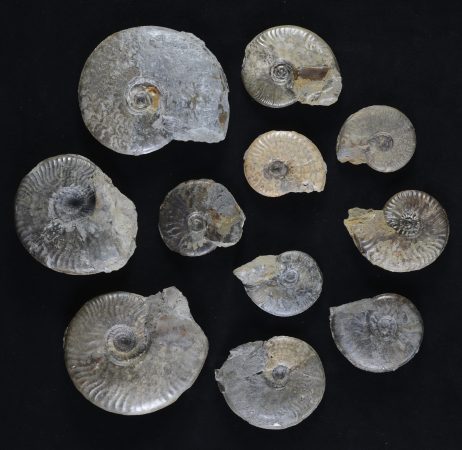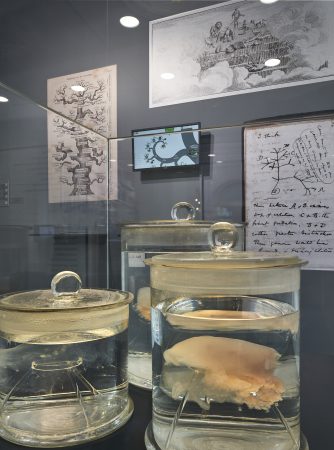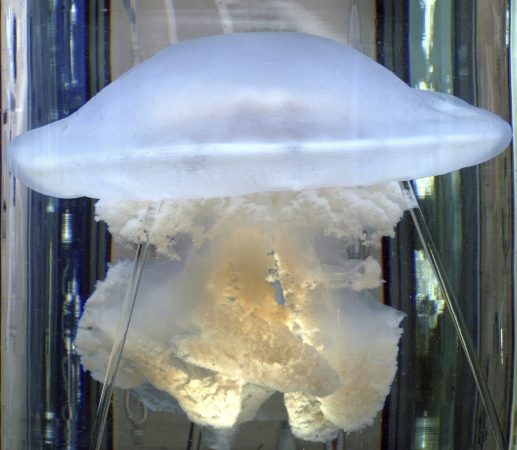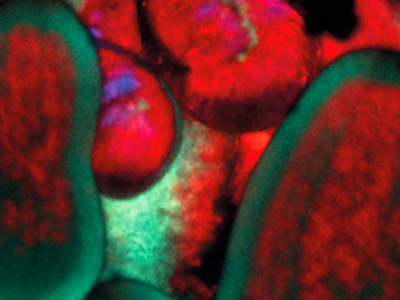Trees of Life
Charles Bonnet
“Scala Naturae”, 1781
The visual metaphor of the Scala Naturae (The Great Chain of Being) dates back to Aristotle (384–322 BC). He wrote the Historia Animalium, in which, based purely on observation, he classified all the animate and inanimate elements of nature into one structure. He concluded that a comprehensive classification system that includes the entire animal kingdom is not possible. He hypothesized that all living beings are part of a timeless continuum without beginning or end. A chronological sequence or evolution was thus inconceivable for him. Aristotle’s ideas were rediscovered in the Middle Ages but interpreted from a Christian perspective, so that humankind was the link between God and the natural and physical world. From this belief emerged Charles Bonnet’s (1720–1793) visual metaphor, which endured within the Western Christian tradition for a long time.
The engraving of Scala Naturae is from Bonnet’s Oeuvres d’histoire naturelle et de philosophie: Contemplation de la nature of 1781. It depicts a philosophy of nature that influenced European thought for centuries and is based on the believed principle of an eternal and immutable universe created by God. Although this was based on Aristotle’s writings, it was expanded with the medieval world view that all living things are ordered hierarchically.
Bonnet’s Scala Naturae shows a metaphysical representation, with a staircase in the middle of the image surrounded by clouds. Placed on the steps from bottom to top are minerals—as an example of inanimate nature, plants, insects, shellfish and snails, fish, birds, and mammals. At the very top is man with his head in the clouds; a detail implying that humankind’s existence lies between the physical world and the spiritual one, namely God. The staircase represents the unifying element between the living beings. The hierarchical representation, which interprets humankind as the perfect completion of nature according to God’s plan and places it at the top of the scale, corresponds to humankind’s understanding of itself during the period before the Enlightenment.
Charles Darwin
“tree-of-life” (sketch of evolution), 1837
The diagram tree-of-life, drawn by Charles Darwin (1809–1882) in in his notebook in 1837, is considered the first attempt to visually depict the phylogenetic development of species. Darwin wrote several notebooks during his five-year voyage around the world. This famous diagram visualizes his not yet formulated idea that all species could be linked by a common ancestry and diversify into different branches. The connections not only branch out vertically, but in all directions. Visual culture expert Horst Bredekamp interprets the line marked with the number 1 as the common ancestor of the species, from which twenty-five branches have developed. A to D represent variants of species 1. The spaces between the letters indicate their differences. The thirteen lines that end with a horizontal line represent species which still exist, while the twelve without a horizontal bar depict those that are already extinct. The length of the branches signifies the duration of the evolutionary processes.
In 1837, Darwin noted in Notebook B: “The tree of life should perhaps be called the coral of life.” After observing a coral he brought with him from his voyage, Darwin identified a more suitable model for the presentation of his thoughts, as it grows from its dead branches over time. In a tree, the branches grow without any horizontal struts. A coral, on the other hand, grows in multiple directions at the same time, without suggesting a hierarchical structure. Because Darwin alternately used the metaphor of a coral or a tree, misinterpretations subsequently ensued. For example, decades later Ernst Haeckel depicted his tree of evolution as a linear, vertical process culminating in the human species.
Darwin’s diagram has great scientific and cultural historical significance because he presented the tree model not as a God-given plan, but as a chronologically evolving process from which the theory of evolution was derived. Darwin hesitated to publish this diagram for more than twenty years because he was aware that his new idea would contravene the then prevailing world view of the Christian church and the creationist line of argument, which considered creation as the work of God and described the privileged position of humankind.
Ernst Haeckel
“Stammbaum des Menschen” (Genealogical tree), 1874
The Berlin-based zoologist Ernst Haeckel (1834–1919) devoted much of his research to the analysis and dissemination of Charles Darwin’s findings after the German translation of On the Origin of Species was published in 1860. His book Anthropogeny, or the Evolution of Man (1874) features the illustration Tree of Life drawn by Haeckel himself.
It features an oak tree that represents the evolution of the species according to Haeckel. The trunk is vertically divided into four areas: protozoans, invertebrate intestinal organisms, vertebrates, and mammals. Haeckel places bacteria at the foundation of the evolutionary process, whereas Darwin did not consider their existence. Even one hundred years after Bonnet’s diagram, the metaphorical tree of evolution still culminates in humankind at its summit.
When considering Haeckel’s Tree of Life, one should not overlook that he considers ideas of lower and higher human races and racial hygiene, which were later adopted by National Socialism. Some science historians believe that Haeckel deliberately positioned man as the culmination of the tree of life in order to increase the acceptance of Darwin’s theory of evolution, despite the still largely Western-Christian worldview. Humankind—and Europeans in particular—were not yet ready to conceive of themselves as just another evolutionary branch. Haeckel’s illustration thus exemplifies humankind’s subjective view of other living beings and the anthropocentric thinking that was in keeping with the spirit of the time. These views, as well as the idea of a continuous and linear upward development, are being strongly challenged by modern science.
David Hillis
“Plot”, 2003
In 2003, the first version of the so-called Hillis Plot appeared in the journal Science, published by evolutionary biologist David Hillis together with scientists Derrick Zwickl and Robin Gutell from the University of Texas. This project originated as an attempt at a new visualization in light of the current knowledge at the time and new laboratory methods. For it was only with DNA sequencing of the genome, which became possible on a broader scale around 1995, that biologists were able to create a comprehensive taxonomic classification showing the relation of organisms to each other.
The Hillis Plot is one of the first phylogenetic illustrations in which the position of humankind is visualized as a systemic part of the whole, and not in a superior position. The classification of species is circular and on one plane. Data on 3000 of the approximately 1.8 million species identified by the accumulated ribosomal RNA gene sequencing method available at the time were provided by hundreds of laboratories and scientists worldwide. The challenge was to synthesize a single visualization from the 7500 partial representations of phylogenetic trees published between 2000 and 2012 alone. As an ongoing international research project accessible to everyone online, the Open Tree of Life visually unites the ever more complex relationships between living organisms. Darwin had already doubted the metaphor of a tree of life, which represents a linear evolution from simpler to more complex species, and considered the image of a coral. Today, however, evolutionary processes are conceptualized as a network of life.
“OneZoom”, 2011
interactive application
This digital application is an interactive tree of life charting the evolutionary relationships between 2,123,179 species. It was created by biologists from the Oxford University Museum of Natural History. Each leaf represents one species and the branches illustrate their direct relationships. This visual metaphor is also a snapshot of the current state of our research and knowledge about evolutionary relationships. The individual species are represented as self-contained entities. This model, too, excludes the processual aspect of evolution: how individuals and species influence and depend on each other and how their adaptation to the environment takes place—all at one particular point in time in a geographical location.
Ammonites of the species Staufenia, Ludwigia and Leioceras
Age: Middle Jurassic, Aalenium, app. 160 million years
Location: Wutach area, Baden Wuerttemberg, Germany
On loan: Senckenberg Gesellschaft für Naturforschung
Ammonites are extinct marine animals—related to the octopus —that lived on the earth for around 140 million years from the Jurassic and Cretaceous period, namely around 200 million years ago. These creatures died out with the dinosaurs. The exhibits are from the collection of the Senckenberg Gesellschaft für Naturforschung and were discovered in the Black Forest. They originate from sediments deposited around 165 million years ago at the bottom of a shallow, tropical sea. Due to their appearance, that is, their morphology, these shells are counted as different (morpho)species. The ammonite shells display countless variations: different ornamentation, ridges, spines, and thorns. In fossils, differentiation according to external characteristics is the only way to be able to define species. Observing many similar specimens raises the question of whether they can be gathered together into a grouping that we call a “species.” Science has chosen a particular method: the concept of the holotype. This means that a particular specimen is defined as the “standard” of a species, so that this is used to compare and determine all other specimens. However, the ontology of scientific explanation brings with it the problem of subjectivity, which means that humankind can only categorize and label the world, or define it as real, in accordance with its own time-bound perception. The anthropocentric view of the world is a unique capability of the human species, but it is also the reason why our perspective finds it difficult to reconcile with the idea that the reality of all other living things can also be considered equivalent.
Definition of the term species
For many years humankind has tried to classify the diversity of nature according to objective criteria. The most important unit here is the “species.” In addition to the morphological species, which is based solely on the appearance of living organisms, there are many other species concepts in the biosciences and geosciences. While biologists advocate for the biological species concept, geneticists support the genetic species and paleontologists the morphological or chronological species. These are just a few examples of dozens of species concepts that have been developed in accordance with each field and are considered valid in their respective disciplines. Paleobotany offers an extraordinary species concept: as it is often only isolated parts of fossilized plants that are preserved, they are often furnished with separate names. However, it may happen that a new find, such as a fern frond clinging to a tree trunk, suddenly combines two species into one.
These differing definitions of species lead to a series of questions: How does a person or a scientist define a species? By what and how many criteria are similarities among species determined? Are these criteria not subjectively determined, and if so, does the classification of species from the human perspective depict reality? Or is it merely a tool to classify nature? If the method of determining species is an inexact practice, what does that say about the models in the Tree of Life? Species concepts are ideas that become language and then assume a form, without which an understanding of what we perceive and consider real would be impossible.
Cotylorhiza tuberculata (Fried egg jellyfish)
Wet preparation, tart
Occurence: Mediterranean Sea
On loan: Senckenberg Gesellschaft für Naturforschung
Humankind has always tried to understand the world around it in systems. The division of living organisms into species is one of these systems. The observation of external characteristics—morphology—is a key method of classification. The shape of living things develops from the essential life functions that the organism needs to exist, so that the nature of an organism is formed afterwards. Movement is a key aspect. For this an organism needs a supporting structure so it does not collapse. Vertebrates and humans have an internal skeleton (bones to which ligaments and musculature can adhere). Many invertebrates such as shellfish or insects have an outer skeleton (a shell to which muscles can adhere). The jellyfish, on the other hand, has no solid structure, yet over the course of millions of years it has been able to ensure its continued existence through so many planetary upheavals. Why has this species been so successful?
Jellyfish have been living in the oceans for more than 500 million years and have survived numerous processes of mass extinction throughout history. They are among the oldest living organisms on the planet, are living fossils, are the foundation for the evolution of all higher animals and form a transition from the unicellular to the multicellular level of development.
Their body consists of 98% water and is only separated from the outside world by single-celled layers. Because of this peculiarity, only a few fossils of these creatures have been found. Jellyfish have a nervous system and sensory organs, but no brain. What made these beings unique survival specialists? Researchers talk about the almost unlimited regenerative capacity of these creatures. They have the ability to respond to an inflicted injury with a signal to reorganize their body. They continually reproduce their radially symmetric form, a form they need to move around and effectively gather food. The mechanism is created by the body’s locomotive system. Jellyfish do not laboriously replace what has been lost, but instead restructure existing material accordingly.
Agathoxylon, petrified trunk of a conifer tree
Age: Lower Triassic, 225 million years
Location: Nevada, USA
On loan from: the Senckenberg Gesellschaft für Naturforschung
Nevada is home to the Petrified Forest National Park. Enormous trunks from conifers that grew here over 225 million years ago have been uncovered by the effects of wind and weather on the surrounding rock over the millennia and now lie exposed in the barren landscape. The fossils bear witness to a time when the climate in today’s deserts was significantly wetter. Fossilized trees are only produced and preserved in special conditions. In the case of this 1.7-ton tree trunk, the wood tissue has been replaced by silica and thus transformed into a fossil. Consequently, the tree became more resistant than the surrounding rock and remained on the surface for millions of years. The colorful interior of this tree trunk is the result of admixtures of various minerals: red and brownish colors indicate rusted iron, green shades are caused by reduced iron or copper.
The exhibits from the Senckenberg Gesellschaft für Naturforschung in the Trees of Life exhibition are not only pieces of scientific evidence, but also fragments of the world in time. The items enable us to establish a relation to periods of time that seem so vast that one can quantify them but cannot grasp or understand them emotively. If one acquires knowledge through scientific research and links it to the questions of origin and meaning, everything tells its own story—of the world, of us, and of how everything is interrelated.

